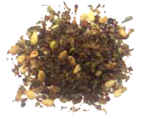 Zatar is to the flavour world what the Spice Girls are to music. Each is an unusual but intrinsically familiar combination of individual elements that technically might work on their own but go best together. Maybe Ginger Spice can make it without the rest of the group and maybe sumac or hyssop should get their own 2 oz container on the spice shelf but I think not. Zatar is to the flavour world what the Spice Girls are to music. Each is an unusual but intrinsically familiar combination of individual elements that technically might work on their own but go best together. Maybe Ginger Spice can make it without the rest of the group and maybe sumac or hyssop should get their own 2 oz container on the spice shelf but I think not.
Zatar, which rhymes with batter, is Arabic for wild thyme and is common to Middle Eastern cooking. It is also spelled za’tar, zaatar, and zahtar.
Rarely sold as a single herb, it is usually packaged as a combination of several herbs and flavours with thyme and sumac dominant. The thyme gives it a loamy perfume and the sumac a slightly bitter woody edge. The flavours balance each other well. Iranian and Lebanese grocery stores often sell zatar in a mix with sesame seeds and salt. Other mixtures might contain paprika, hyssop (an aromatic minty plant), olive wood, marjoram, or oregano.
Traditionally, zatar is served with pita bread and olive oil. Dip the bread in the oil and then the herb mix; or make a paste of the oil and herbs, brush it over bread or pita and grill for a few minutes. Pita bread already baked with a zatar topping is available in Middle Eastern stores throughout the Montreal area. Many people also enjoy zatar sprinkled on ripe tomatoes or dusted over thick Lebanese yogurt or added to a yogurty mayonnaise for a vegetable dip. Zatar also makes for a wonderful alternative to the ubiquitous European mixture known as herbes de provence in recipes for dishes like roasted chicken or lamb stew. 
© Barry Lazar 2000  |

|
|